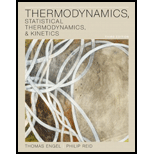
(a)
Interpretation: Whether the given process 1 is spontaneous or non-spontaneous needs to be determined.
Concept Introduction: There are two types of the
(b)
Interpretation: Whether the given process 2 is spontaneous or non-spontaneous needs to be determined.
Concept Introduction: There are two types of the chemical reactions occurring in the environment that is spontaneous reaction and non-spontaneous reactions. Spontaneous reactions are exergonic thus, decrease in the enthalpy and increase in the entropy of the system takes place. On the other hand, the endergonic reactions are non-spontaneous.
(c)
Interpretation: Whether the given process 3 is spontaneous or non-spontaneous needs to be determined.
Concept Introduction: There are two types of the chemical reactions occurring in the environment that is spontaneous reaction and non-spontaneous reactions. Spontaneous reactions are exergonic thus, decrease in the enthalpy and increase in the entropy of the system takes place. On the other hand, the endergonic reactions are non-spontaneous.
(d)
Interpretation: Whether the given process 4 is spontaneous or non-spontaneous needs to be determined.
Concept Introduction: There are two types of the chemical reactions occurring in the environment that is spontaneous reaction and non-spontaneous reactions. Spontaneous reactions are exergonic thus, decrease in the enthalpy and increase in the entropy of the system takes place. On the other hand, the endergonic reactions are non-spontaneous.
Want to see the full answer?
Check out a sample textbook solution
Chapter 5 Solutions
Thermodynamics, Statistical Thermodynamics, & Kinetics
- Determine the standard Gibbs free energy change, rG, for the reactions of liquid methanol, of CO(g), and ofethyne, C2H2(g), with oxygen gas to form gaseous carbondioxide and (if hydrogen is present) liquid water at298 K. Use your calculations to decide which of thesesubstances are kinetically stable and which are thermodynamically stable: CH3OH(), CO(g), C2H9(g), CO2(g),H2O().arrow_forwardWhat is the sign of the standard Gibbs free-energy change at low temperatures and at high temperatures for the combustion of acetaldehyde? CH3CHO(l)+52O2(g)2CO2+2H2O(l)arrow_forwardWhat is the sign of the standard Gibbs free-energy change at low temperatures and at high temperatures for the synthesis of ammonia? 3H2(g) + N2(g) 2NH3(g)arrow_forward
- What is the sign of the standard Gibbs free-energy change at low temperatures and at high temperatures for the decomposition of phosgene? COCl2(g)CO(g)+Cl2(g)arrow_forwardCalculate the standard Gibbs free-energy change when SO3 forms from SO2 and O2 at 298 K. Why is sulfur trioxide an important substance to study? (Hint: What happens when it combines with water?)arrow_forwardBillions of pounds of acetic acid are made each year, much of it by the reaction of methanol with carbon monoxide. (AssumeT= 298 K.) CH3OH() + CO(g) CH3COOH() (a) By calculating the standard Gibbs free energy change, rG, for this reaction, show that it is product-favored. (b) Determine the standard Gibbs free energy change, rG,for the reaction of acetic acid with oxygen to form gaseous carbon dioxide and liquid water. (c) Based on this result, is acetic acid thermodynamicallystable compared with CO2(g) and H2O()? (d) Is acetic acid kinetically stable compared with CO2(g)and H2O()?arrow_forward
- Appendix J lists standard molar entropies S, not standard entropies of formation rS. Why is this possible forentropy but not for internal energy, enthalpy, or Gibbsfree energy?arrow_forwardThe standard molar entropy of methanol vapor, CH3OH(g), is 239.8 J K1 mol-1. (a) Calculate the entropy change for the vaporization of 1 mol methanol (use data from Table 16.1 or Appendix J). (b) Calculate the enthalpy of vaporization of methanol, assuming that rS doesnt depend on temperature and taking the boiling point of methanol to be 64.6C.arrow_forwardWhat are the two ways that a final chemical state of a system can be more probable than its initial state?arrow_forward
 Chemistry & Chemical ReactivityChemistryISBN:9781133949640Author:John C. Kotz, Paul M. Treichel, John Townsend, David TreichelPublisher:Cengage Learning
Chemistry & Chemical ReactivityChemistryISBN:9781133949640Author:John C. Kotz, Paul M. Treichel, John Townsend, David TreichelPublisher:Cengage Learning Principles of Modern ChemistryChemistryISBN:9781305079113Author:David W. Oxtoby, H. Pat Gillis, Laurie J. ButlerPublisher:Cengage Learning
Principles of Modern ChemistryChemistryISBN:9781305079113Author:David W. Oxtoby, H. Pat Gillis, Laurie J. ButlerPublisher:Cengage Learning Physical ChemistryChemistryISBN:9781133958437Author:Ball, David W. (david Warren), BAER, TomasPublisher:Wadsworth Cengage Learning,
Physical ChemistryChemistryISBN:9781133958437Author:Ball, David W. (david Warren), BAER, TomasPublisher:Wadsworth Cengage Learning, Chemistry: The Molecular ScienceChemistryISBN:9781285199047Author:John W. Moore, Conrad L. StanitskiPublisher:Cengage Learning
Chemistry: The Molecular ScienceChemistryISBN:9781285199047Author:John W. Moore, Conrad L. StanitskiPublisher:Cengage Learning Chemistry & Chemical ReactivityChemistryISBN:9781337399074Author:John C. Kotz, Paul M. Treichel, John Townsend, David TreichelPublisher:Cengage Learning
Chemistry & Chemical ReactivityChemistryISBN:9781337399074Author:John C. Kotz, Paul M. Treichel, John Townsend, David TreichelPublisher:Cengage Learning





